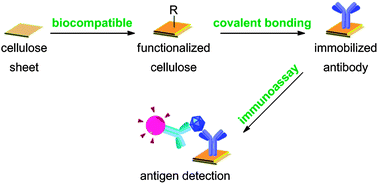A one-step and biocompatible cellulose functionalization for covalent antibody immobilization on immunoassay membranes†
Abstract
Among bioactive papers, many multiplexed assays implement methods incompatible with the conventional lateral flow immunoassay (LFIA) carrier material, nitrocellulose. Consequently, its replacement by cellulose has to be considered. This technological breakthrough requires a surface chemistry which ensures both the biomolecules covalent grafting to cellulose and the conservation of their biological activity. To comply with these requirements, the process elaborated in this study implements compounds and methods compatible with biological material. While cellulose chemical modification is usually operated under harsh conditions in organic


 Please wait while we load your content...
Please wait while we load your content...